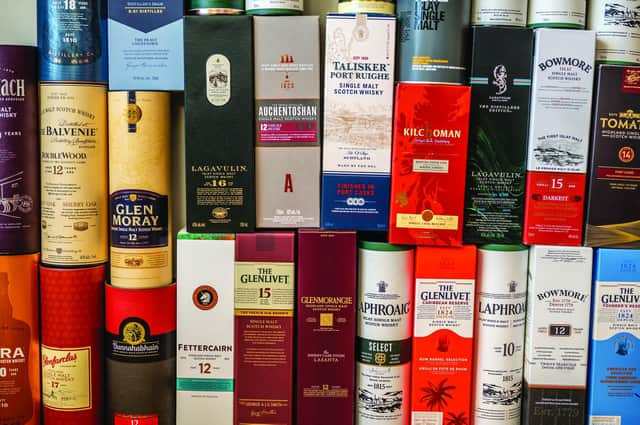Whisky: origins of the whisky trail distilled


It is thought it was Scotland’s pious monks who were first to distil for medicinal reasons during the Middle Ages with evidence of distilling found at Lindores Abbey in Fife. A Friar John Cor appeared in the first written record of distilling in 1494 when he received “eight bolls of malt... to make aqua vitae”. Those eight bolls were enough to make almost 1,500 bottles of alcohol.
Amid a growing taste for the spirit, taxation on whisky making began in Scotland in the mid-17th Century, but the regimes varied between the Highlands and the Lowlands and created division. In the Central Belt, whisky was made quickly and crudely in big stills with the “noxious spirit” largely bound for London. In the Highlands and Islands, where some smaller licensed operations emerged, illicit distilling remained key. Small stills, where distillation is slower, were moved around easily and quietly slipped out of view with the natural landscape providing perfect cover for operations. What was made outside the law was often considered a far finer product, setting the Lowland makers against the Highland way.
Advertisement
Hide AdAdvertisement
Hide AdIn Islay, more than 90 stills were seized in 1795 after the first exciseman finally arrived on the island, where no revenues had been paid for at least ten years, and legend has it Cnoc nc Croiche – or Gallows Hill – had the rope ready especially for the tax collector.


Meanwhile, at Blackmiddens in Cabrach on the Moray border, illegal distilling was rife, with whisky being smuggled into Aberdeen in coffins placed on horse-drawn carriages, and locals lowering their heads as the cargo passed in a further ruse to foil officials.
By the 1820s, as many as 14,000 illicit stills were being confiscated every year in Scotland and more than half the whisky consumed enjoyed free of the taxman’s penny.
The Excise Act of 1823 sought to change all this.
The highly detailed legislation was passed as William Pitt’s government sought to get a grip of excise amid the broader landscape of industrialisation with the act highly-detailed legislation containing designs of permitted distilleries, measurements and the requirements for an exciseman’s house on site.
Nick Morgan, whisky historian and writer, says: “Unless there had been the fundamental change which the act brought in, the industry as we know it would not have developed and not have developed so quickly.
“In Scotland, from the late 18th Century up until 1823 you had this very legal divide between Lowlands and Highlands.
“The big lowland distilleries, Kennetpans and Kilbagie [in Clackmannanshire] were making whisky very, very quickly in short, sharp distillations, and that is why whisky didn’t necessarily have a great reputation. Up in the Highlands, distilling was really a product of pretty low-quality agricultural production, and for many farmers who did grow barley it was one of the ways of turning their crops into a cash crop. You could sell your spirit, mostly to smugglerswho – although they have been heavily romanticised – I suspect they were about as romantic as Mexican drug cartels.”
Landlords, concerned about lawlessness and making more money from their land and tenants, lobbied heavily for the new laws alongside licensed distillers.
Advertisement
Hide AdAdvertisement
Hide AdNick adds: “These licensed distillers also complained bitterly that they were being put out of business by people who weren’t paying duty or paying for licences.
“The act puts everyone under the same regime. In one sense it is about freedom to distil, but it is freedom to distil in a very heavily regulated way.”
The act, in turn, led to a boom in capitalist investment in whisky making, with the number of licensed distilleries rising from around 120 to more than 300 by 1825.
Nick notes: “Some of these people, like the famous Cumming family at Cardhu, were illicit distillers who took out a licence so overnight it is like the end of Prohibition.”
“Some were just capitalist distillers who just came in with money and didn’t necessarily have great distilling knowledge, so that 300 or so in 1825 went down to around 120 in 20 or 30 years. So there is a huge boom – and then people find it a bit harder than they thought to make money out of it.”
The skills of illicit distillers were in demand following 1823, not least at Drumin in Speyside where George Smith became the first in the area to take out a licence after 1823. He was supported by local landowner Duke of Gordon, who lobbied for the new laws and gave his tenant two pistols for protection.
What Smith created at Drumin became the world-famous Glenlivet, with today’s distillery sitting about a mileaway from Smith’s first legal still.
Nick says: “There was another family called Smith near Upper Drumin. One of them was prosecuted for assaulting an excise officer in 1825, so when the new laws came in they were still making whisky illegally.
Advertisement
Hide AdAdvertisement
Hide Ad“Gradually what happened is that this Smith family – all illegal distillers – went to work for the other Smith family and it was these illicit distilling skills that made Glenlivet famous.
“They were disrupting what was quite a long established business. It was like London black cab workers going on strike because of Uber.”
Nick says it took around 25 years following the introduction of the act for the new industry to settle down, adding: “There were still places where illicit stills went on, such as Strathdon in Aberdeenshire, which was a hotbed of illicit distilling even into the late 1880s.
“There were outposts of people still doing it, but I would say, 25 years after the act, it was a new world for whisky.”